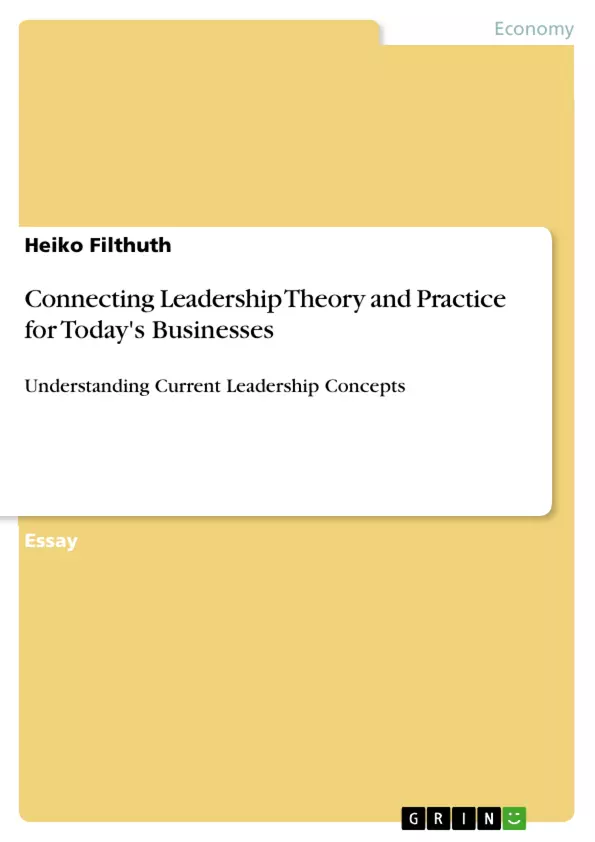Many of today’s leadership models derive from theories created long before the term ‘leadership’ was coined. To understand these recent models, it is important to know where they developed from. This essay considers some of the initial leadership theories and connects them with their recent followers before exploring how leadership theory is applied in today’s management practice.
Since the forming of groups at the beginning of mankind, leaders headed groups of individuals, some by choice of the group, some by personality, some took leadership by force, and others led by what they assumed to be divine right. Leadership developed over time, but even the most contemporary leadership styles still bear close links with their roots. To consider the connections of today’s leadership with the initial models, the history of leadership is briefly visited, and recent theories are explained before a link between leadership theory and practice and the application of leadership is made.
Inhaltsverzeichnis (Table of Contents)
- A Brief History of Leadership Theory
- Selected Early and Recent Leadership Theories
- Recent Leadership Theories aligned to Traits Theories
- Recent Leadership Theories aligned to Behavioural Theories
- Recent Leadership Theories aligned to Contingency Theories
- Recent Leadership Theories aligned to Power-Influence Theories
- Leadership Evolving Over Time
- Recent Leadership Theories
- How Early and Recent Theories Connect
- Historical Theories in a Current Context
- Connecting Leadership Theory and Practice
- Connecting Early and Recent Leadership Theories
Zielsetzung und Themenschwerpunkte (Objectives and Key Themes)
This essay aims to explore the development of leadership theories throughout history and connect them to their application in today's business practices. It traces the evolution of leadership models, starting with early theories and culminating in contemporary approaches. The essay also highlights the relationship between leadership theory and practice, demonstrating how historical insights continue to inform modern leadership approaches.
- Historical evolution of leadership theories
- The relationship between early and contemporary leadership models
- The application of leadership theories in modern business practices
- The impact of cultural and social changes on leadership
- The distinction between leadership and management
Zusammenfassung der Kapitel (Chapter Summaries)
- A Brief History of Leadership Theory: This chapter introduces the origins of the term "leadership" and traces its development from the early days of group formation to the modern era. It also explores how early leadership styles have influenced contemporary models.
- Selected Early and Recent Leadership Theories: This section presents a selection of prominent leadership theories, covering both historical and recent models. It explores the key characteristics, strengths, and weaknesses of each theory, providing a comprehensive overview of the field.
- Leadership Evolving Over Time: This chapter examines how leadership theories have evolved over time, highlighting the key shifts and changes in perspective. It emphasizes the role of social, economic, and cultural influences on the development of leadership models.
- Recent Leadership Theories: This section dives into nine contemporary leadership theories that have emerged in recent years. It categorizes these theories into four major groups: Trait Theories, Behavioural Theories, Contingency Theories, and Power-Influence Theories, and provides detailed explanations of each theory.
- How Early and Recent Theories Connect: This chapter explores the interconnectedness of early and contemporary leadership theories, demonstrating how later models build upon and refine earlier concepts. It highlights the common threads that run through various theories, emphasizing the continuous evolution of leadership understanding.
- Historical Theories in a Current Context: This section examines the relevance of historical leadership theories in today's business environment. It highlights how contemporary organizations and individuals continue to draw on insights from past models, demonstrating their enduring value.
- Connecting Leadership Theory and Practice: This chapter brings the essay to a close by exploring the relationship between leadership theory and practice. It examines how historical insights inform modern leadership approaches, demonstrating the practical application of theoretical frameworks.
Schlüsselwörter (Keywords)
This essay explores a wide range of leadership theories, including Great Man Theory, Trait Theory, Behavioural Theory, Contingency Theory, Transactional Leadership, Transformational Leadership, Authentic Leadership, Neo-charismatic Leadership, Implicit Leadership, Responsible Leadership, Ethical Leadership, Entrepreneurial Leadership, Complexity Leadership, Shared Leadership, Distributed Leadership, Collective Leadership, and e-Leadership. It also delves into key concepts such as leadership development, cultural influences, change management, and the distinction between leadership and management. These keywords offer a comprehensive overview of the essay's core topics and focus areas.
- Quote paper
- Heiko Filthuth (Author), 2018, Connecting Leadership Theory and Practice for Today's Businesses, Munich, GRIN Verlag, https://www.hausarbeiten.de/document/541348


